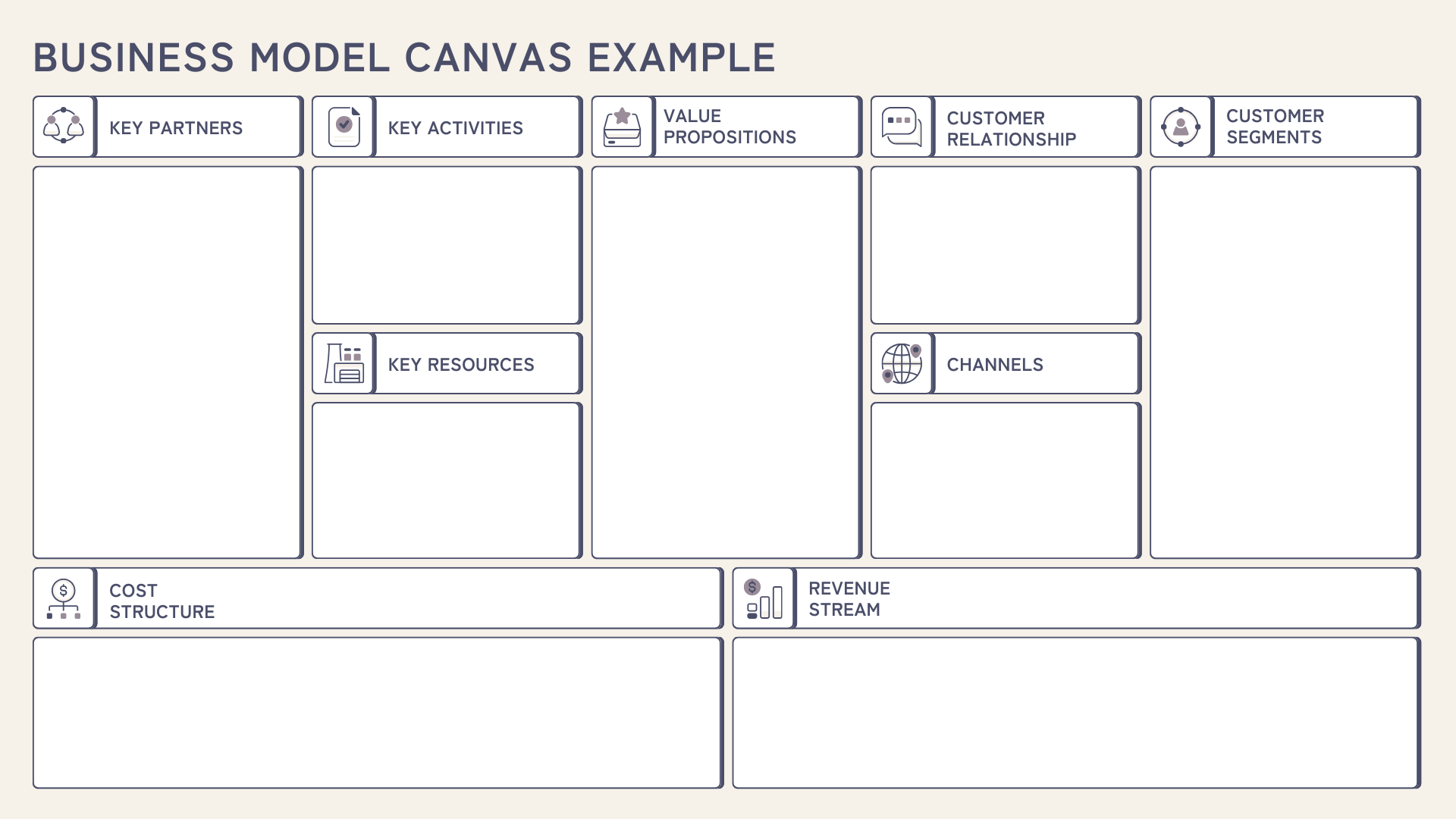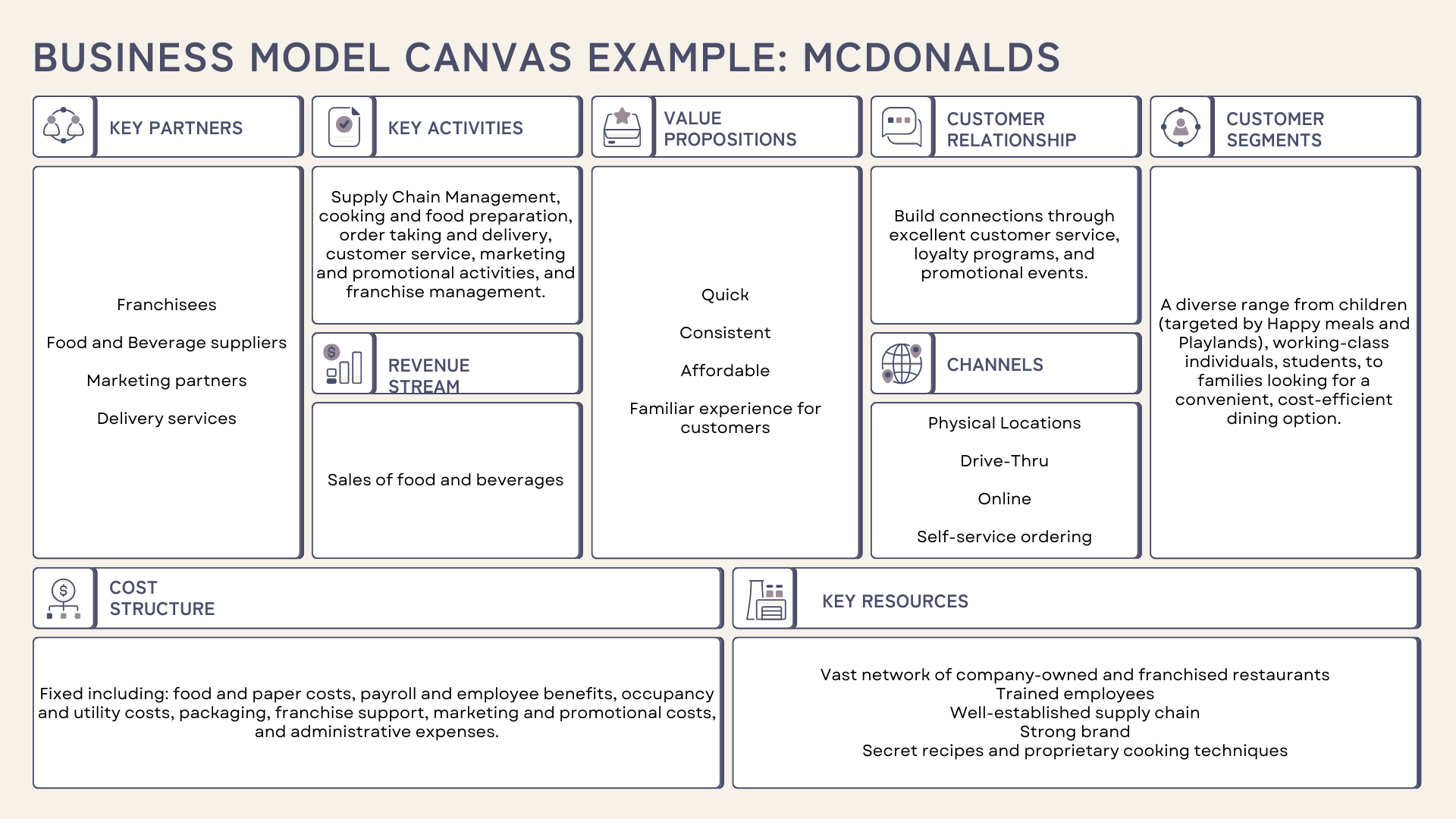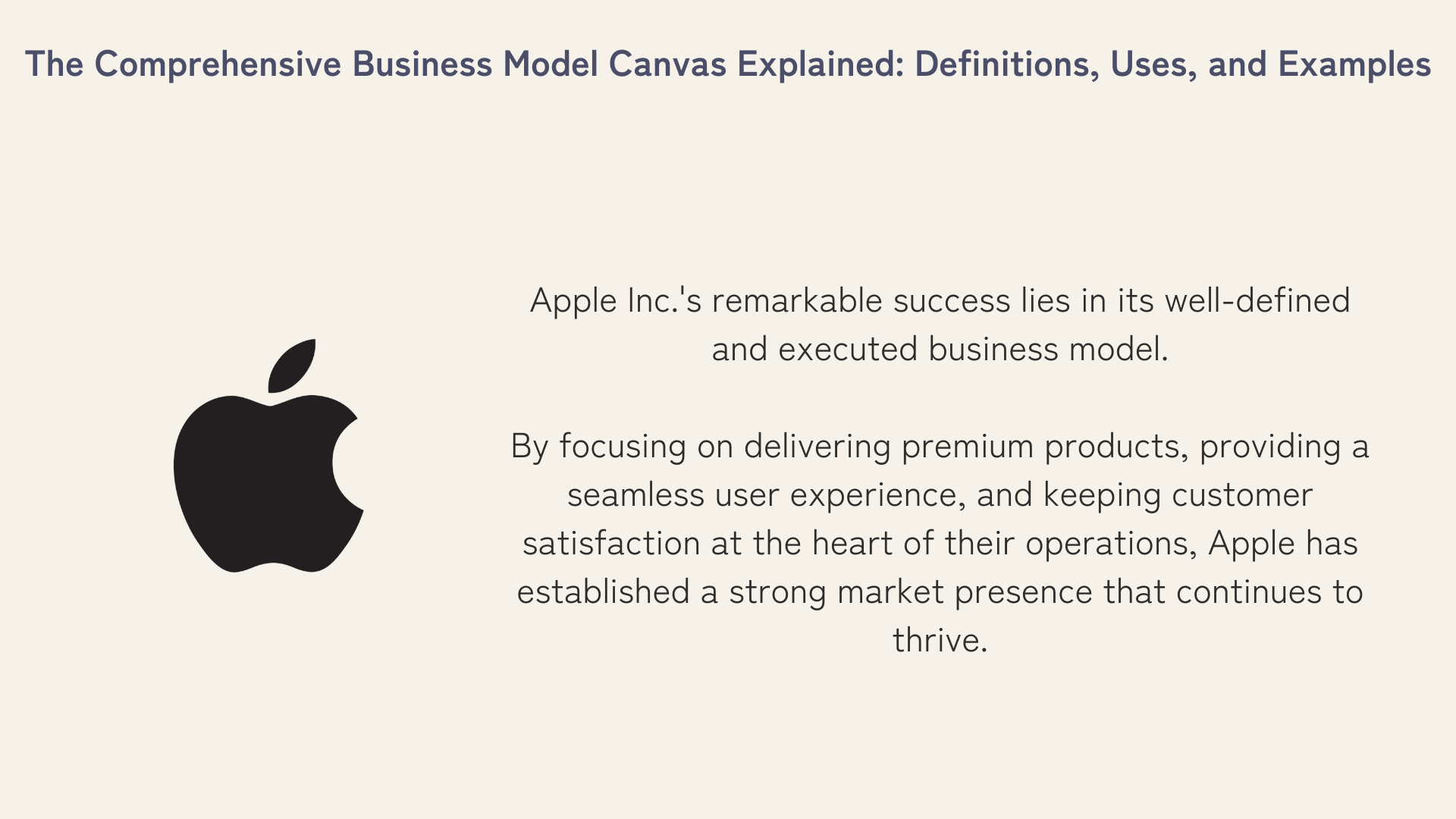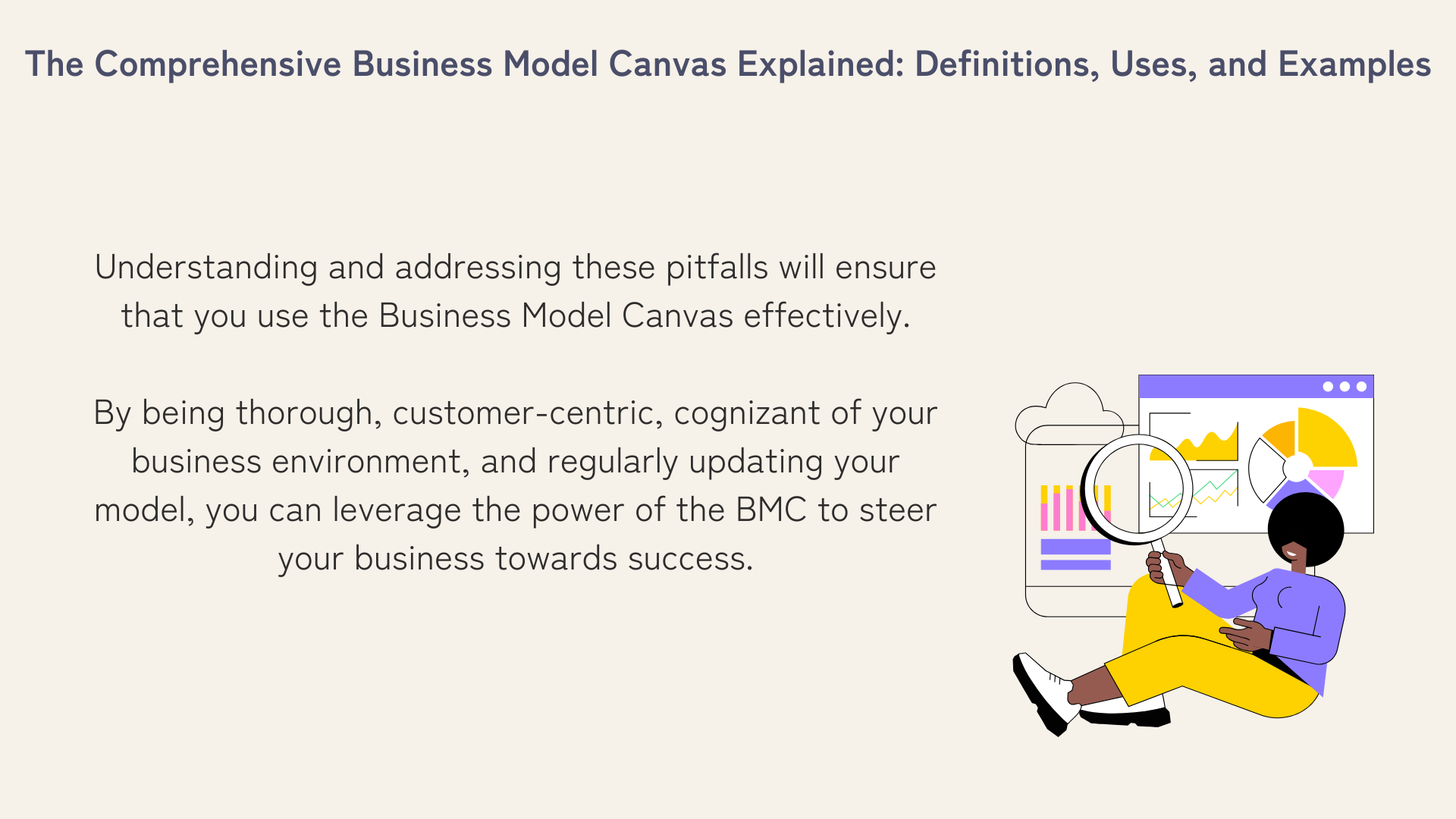Introduction
Business Model Canvas (BMC) is an invaluable tool used by organizations to shape a firm and resilient business model.
It visualizes business elements and their interrelationships, allowing companies to achieve more strategic operational decisions.
This visual diagram, encompassing key areas like value propositions, customer segments, and revenue streams, can tell you much about the health of a business or potential avenues for innovation.
In this blog post, we will provide an in-depth exploration of the BMC, delving into detailed definitions, practical uses, and real-world examples from successful corporations.
Overview of the Business Model Canvas
A Business Model Canvas is a strategic management and entrepreneurial tool that allows you to describe, design, challenge, invent, and pivot your business model.
The visual nature of the BMC breaks down complex business model ideas into relatable, straightforward terms.
Businesses can reap several benefits by using BMC. It offers a simplified understanding of business propositions and focuses on operational areas that require attention.
Additionally, it facilitates conversation about your business model and offers a flexible way to strategize potential avenues for growth.
Key Components of a Business Model Canvas
The primary components of a business model include the value proposition, customer segments, channels, customer relationships, revenue streams, key resources, key activities, key partnerships, and cost structure.
Let's unravel each component with the help of some well-aligned examples.
- Value Proposition - Expresses the reasons why customers should buy from you and not your competition. It's all about the problem-solution fit.
- Customer Segments - Identifies the different groups of people a company aims to reach and serve. This is knowing who will buy your product or service.
- Channels - Show the mediums through which a company communicates with and reaches its customer segments to deliver its value proposition. For example Amazon uses its online marketplace as its primary channel, complemented by mobile apps, and brick-and-mortar stores like Whole Foods and Amazon Go.
- Customer Relationships - Describes the type of relationship a company establishes with its specific customer segments.
- Revenue Streams - The revenue streams element reflects how much each customer segment is willing to pay. For instance, Netflix operates a subscription-based business model with three primary subscription plans, with each priced differently based on the value offered.
- Key Resources - Identifies the resources needed to create value for the customer. They are considered an asset to a company, which are needed in order to sustain and support the business.
- Key Activities - Are the crucial actions needed to implement a company's business model.
- Key Partnerships - Networks of suppliers and partners that help the business model work.
- Cost Structure - Describes all costs incurred to operate a business model. For example, the cost structure of a software-as-a-service (SaaS) company such as Slack includes costs for software development, customer acquisition (marketing, sales), hosting services and customer support.
How to Create a Business Model Canvas for Your Business
Understanding what your business model is can be simple, but figuring out how to effectively utilize it can seem daunting.
This section provides a step-by-step guide on how to utilize the Business Model Canvas (BMC) to create and innovate your business model effectively.
Step 1: Draw Your Canvas
Start by drawing a large rectangle, then divide it into 9 sections as per the BMC elements.
You can do this on a whiteboard, large sheet of paper, or use a digital template.
This visual aid will map out your current business model and serve as a framework for your future business planning.

Step 2: Fill Out the Canvas
Begin with the central components of the BMC: Value Proposition and Customer Segments.
These two should align well, as your value proposition specifically satisfies the needs or challenges of your identified customer segments.
Next, define Channels and Customer Relationships. Channels deal with how you interact with your customer segments and deliver value, while customer relationships outline how you attract, retain, and grow your customer base.
Now, move on to define the remaining components:
For Key Resources, identify main assets required to create and deliver your value proposition.
When detailing Key Activities, list essential tasks needed to put your business plan into action.
Under Key Partnerships, note important relationships with third parties that support your business model.
Lastly, identify your cost structures and revenue streams. Ensure they align well with your value proposition and serve your customer segments.
Here is the Example of Business Model of McDonald’s:

Step 3: Analyze and Adjust
After filling out the BMC, spend time analyzing each component. Do they align with one another?
Do your key partnerships support your key activities, and are they enabling you to deliver your value proposition effectively?
Consider how changes in one area can impact others. For example, if you decide to change your Channels by offering your product online, it may affect your cost structure due to additional costs for online marketing and shipping.
Step 4: Validate Your Business Model
Testing your assumptions in the real world is crucial. Use feedback from stakeholders, customers, partners, and markets to validate whether your value proposition is truly valuable to your customer segments, and if your channels are effective in reaching them.
Also, ensure your revenue streams are profitable enough to cover the cost structure.
Make adjustments based on your findings, repeat the process until you've refined an effective and efficient business model.
Step 5: Iterate and Evolve Your Business Model
Remember, your business is dynamic and ever-changing. Regularly revisit and revise your Business Model Canvas to reflect shifts in your business environment, customer behavior, heightened competition, or changes in technology.
Improving your business model is an ongoing process.
Real-World Example: Decoding Apple Inc's Business Model Canvas
Apple Inc., one of the most renowned multinational technology companies globally, consistently captivates audiences with its innovative products.
Across the world, both consumers and scholars marvel at the effectiveness of Apple's business model.
Let's break down each segment to see how they apply to Apple Inc.
1. Value Propositions
Apple's value proposition lies in its commitment to design, detail, and innovation, coupled with a focus on delivering a seamless and intuitive user experience.
Their products, known for their high performance and premium design, justify their premium pricing strategy.
For instance, the iPhone, with its sophisticated design and cutting-edge functionality, has become a must-have for consumers worldwide.
2. Customer Segments
Apple targets a wide range of customer segments ranging from average consumers, business users, and students to educators and professionals.
Although their products are priced higher than most of their competitors, the brand’s strong appeal draws customers from all income categories and regions.
3. Channels
Apple distributes its products through a variety of channels:
- Retail Stores: Apple's own branded stores, located in top-tier markets worldwide, provide a notable shopping experience and excellent customer service.
- Online Stores: Products are also accessible through Apple's online store and App Store.
- Third-party Retailers: Products and services are also distributed through network carriers, wholesalers, retailers, and value-added resellers.
4. Customer Relationships
Apple's strong customer relationships are maintained through direct interactions in retail stores and workshops.
Additionally, their well-equipped customer service plays a vital role in maintaining these relationships.
The Apple Support Page, AppleCare+, and the Genius Bar at retail stores provide seamless after-sales service.
5. Revenue Streams
Apple's primary source of revenue is the sale of its hardware products like iPhones, iPads, Macs, and Apple Watches.
Apart from this, the company also earns considerable income from services like Apple Music, iTunes, App Store, iCloud, and Apple Pay.
The 'Services' category has been Apple's fastest-growing revenue segment in recent years.
6. Key Activities
Apple's key activities range from R&D, product design, software development, product manufacture, distribution, marketing, and sales to customer service.
Their commitment to continuous innovation and the creation of market-defining products makes their R&D department one of the most crucial aspects of their business.
7. Key Resources
Apple's key resources include its proprietary software and hardware, its retail stores, distribution network, manufacturing partners, and, most importantly, its team of innovators, designers, and engineers — the driving forces behind Apple's groundbreaking products.
8. Key Partnerships
While Apple aims to control the customer experience by owning the hardware, user interface, and software, it still cultivates vital partnerships.
Key partners include Intel (for processors), Samsung (for iPhone screens), and Google (as the default search engine for Safari). It also partners with logistics providers and countless app developers that contribute to the Apple ecosystem.
9. Cost Structure
The cost structure includes costs associated with R&D, design, manufacturing, staff salaries, marketing and advertising, delivery, after-sales service, and maintaining Apple stores.
Despite these substantial costs, Apple's profit margins remain exceedingly high due to its premium pricing strategy.

Common Pitfalls to Avoid while Using the Business Model Canvas
While the Business Model Canvas (BMC) is an incredibly effective tool for planning, strategizing, and understanding a business model, it is not foolproof.
To maximize its benefits, one must understand and avoid common pitfalls. Here are some common mistakes and ways to avoid them while using the BMC.
1. Overgeneralization of Customer Segments
One common mistake businesses make is overgeneralizing their customer segments. Different customer groups may have distinct needs, thus requiring unique value propositions.
For example, a software company may have customer segments that include individual consumers, small businesses, and large corporations.
Segment your customers based on their distinct needs, characteristics, or behaviors.
Tailor specific value propositions to each segment for better market targeting and customer satisfaction.
2. Incomplete Value Proposition
An incomplete or non-specific value proposition is another common pitfall when using the BMC.
This usually happens when businesses focus too much on product features and not on the benefits they offer.
Suppose a music streaming service focuses on features such as offering millions of songs and hi-def audio.
While these are valid points, the real value for most customers might be a personalized music experience or discovering new artists.
3. Neglecting Key Partnerships
Many businesses tend to overlook the 'Key Partnerships' block, thinking they can go to market independently.
In reality, key partnerships can provide major competitive advantages and are crucial to long-term business success.
Identify strategic partnerships that can help your business grow. Partnerships can assist with marketing, distribution, supply, product development, and more.
4. Ignoring Costs and Revenue Streams
Often businesses get absorbed in designing their products, services, channels, and customer relationships that they neglect their cost structures and revenue streams. This oversight can result in an unsustainable business model.
Identify all possible costs and ensure they are balanced with revenue streams.
Test various pricing strategies to discover what offers maximum value to customers while keeping the business profitable.
5. Not Updating the BMC
This is perhaps the most common pitfall. The BMC needs to be a living, evolving document that changes as the business grows, scales, pivots, or reacts to changes in the market or industry.
Netflix is a perfect example; it shifted from a DVD rental service to a streaming service, dramatically changing their business model.
Regularly revisit your BMC. Audit it against market trends, consumer behavior, advancements in technology, and competitive benchmarks.
Update it as needed to ensure it always aligns with your current business reality.

Conclusion
Your Business Model Canvas serves as the backbone of your growth strategy, capturing all essential aspects of your business on one page.
Its power lies in visualizing your business's core facets and identifying areas of strength and improvement.
By studying the examples we've explored, you can better leverage the BMC to unlock the potential in your own business operations.
Always remember, the most effective business model is one that continually adapts to the evolving market needs and opportunities.
Start creating your BMC today and navigate your way to business success.








